Canine distemper is a highly contagious and potentially fatal viral disease that primarily affects dogs, though it can also impact other animals, such as raccoons and foxes. Understanding canine distemper is crucial for pet owners and veterinarians alike and you can find all the information you need about this dog diseases – distemper.
What is Dog Diseases Distemper?
Dog Dieseases distemper, often simply referred to as “distemper,” is a highly contagious viral disease that affects dogs, as well as other animals such as raccoons, foxes, and certain species of wild cats. It is caused by the canine distemper virus (CDV), which is a member of the Morbillivirus genus. Canine distemper is a serious and potentially fatal disease, and it can affect various body systems, leading to a wide range of symptoms.
The virus is primarily spread through direct contact with an infected dog’s bodily fluids, such as nasal discharge, saliva, urine, and feces. It can also be transmitted through the air when an infected animal coughs or sneezes.

What is Canine Distemper
What are the Symptoms of Canine Distemper?
Dog Diseases Distemper is a viral disease that can manifest a wide range of symptoms. The specific symptoms and their severity can vary from one infected dog to another. Here are some common symptoms of canine distemper:
- Fever: An elevated body temperature is often one of the first signs of distemper.
- Nasal and Ocular Discharge: Infected dogs may have a watery or pus-like discharge from the nose and eyes.
- Coughing and Sneezing: Respiratory symptoms, such as coughing and sneezing, can occur.
- Lethargy: Dogs with distemper often become lethargic, displaying a lack of energy or interest in usual activities.
- Loss of Appetite: Infected dogs may refuse to eat or show a significant decrease in appetite.
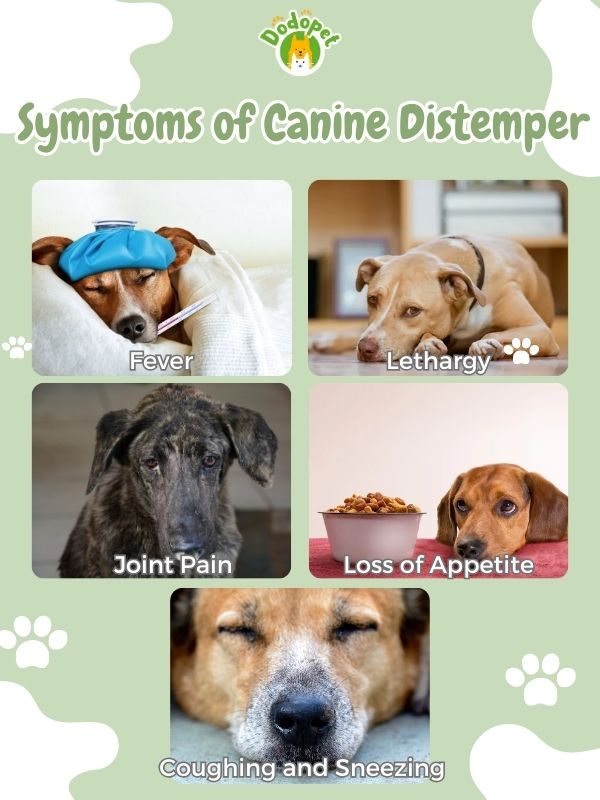
Symptoms of Canine DistemperSymptoms of Dog Diseases from Ticks
In the later stages of the disease, dogs may develop more severe symptoms such as:
- Vomiting and Diarrhea: Moving on to gastrointestinal symptoms, these often manifest as vomiting and diarrhea.
- Eye Issues: Additionally, distemper can result in ocular complications, including inflammation of the eyes, which can lead to symptoms such as squinting, redness, and discharge.
- Neurological Symptoms: In more severe instances, the disease can extend to the nervous system, resulting in a range of neurological symptoms. These may encompass muscle twitches, seizures, incoordination, and behavioral changes.
- Dental Issues: Furthermore, some affected dogs may experience dental problems, specifically dental enamel hypoplasia, which gives rise to teeth with a rough or pitted appearance.
- Skin and Footpad Changes: The virus can also induce changes in the skin and footpads, characterized by skin rashes and the thickening of the footpads.
- Difficulty Breathing: In advanced cases, dogs may have difficulty breathing due to pneumonia, a secondary infection that can occur.
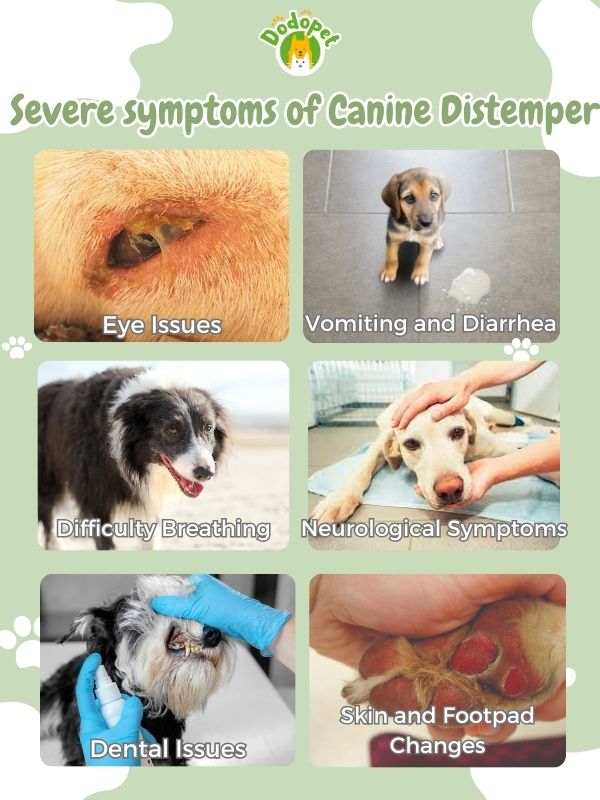
Severe symptoms of Canine Distemper
How is Dog Diseases Distemper Diagnosed?
Diagnosing canine distemper typically involves a combination of clinical examination, medical history, and laboratory tests. Here are the common methods used for diagnosing canine distemper:
- Clinical Examination: A veterinarian will start by conducting a thorough physical examination of the dog. They will assess the dog’s overall health, check for typical symptoms such as nasal discharge, coughing, eye discharge, and skin changes, and inquire about the dog’s vaccination history and recent exposure to other animals.
- Medical History: The dog’s medical history is important for understanding potential risk factors and the progression of symptoms. Knowing the dog’s vaccination status and any recent contact with infected animals is crucial.
- Blood Tests: Blood tests, such as a complete blood count (CBC) and serum biochemistry, can provide important information about the dog’s overall health and any abnormalities that may be associated with distemper. However, these tests are not definitive for diagnosing distemper but can be helpful in assessing the dog’s condition.
- Serological Tests: Specific serological tests, like enzyme-linked immunosorbent assay (ELISA) or virus neutralization tests, can detect antibodies to the distemper virus in the dog’s blood. These tests can indicate past exposure to the virus or current infection. However, they may not be reliable in the early stages of infection.
- PCR Testing: Polymerase chain reaction (PCR) tests can detect the presence of the distemper virus’s genetic material in various bodily fluids, such as nasal secretions, blood, or cerebrospinal fluid. PCR is a more specific diagnostic tool and can confirm active infection.
- Cerebrospinal Fluid Analysis: In cases where neurological symptoms are present, a cerebrospinal fluid analysis may be performed to check for the presence of the virus in the central nervous system.
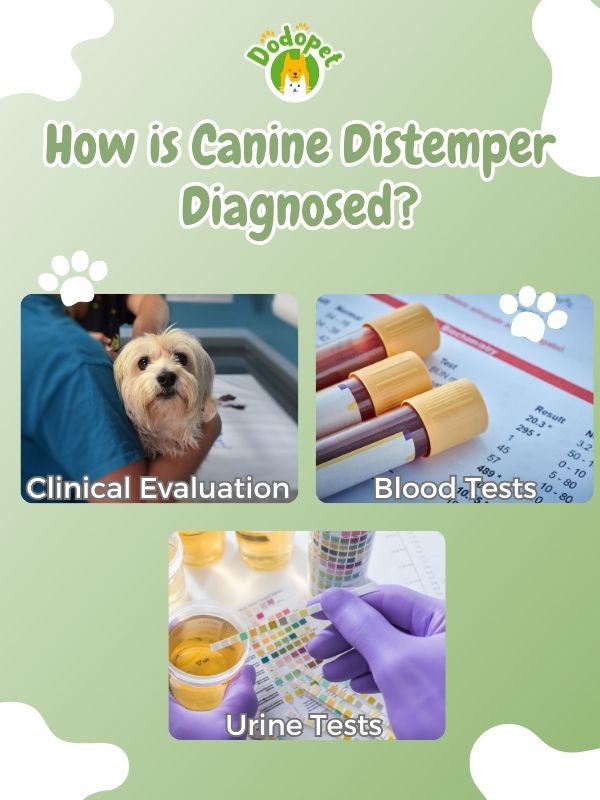
How is Canine Distemper Diagnosed
What is the Treatment for Dog Diseases Distemper?
In addressing canine distemper, supportive care takes precedence, given the absence of specific antiviral medication designed to combat the distemper virus. The primary aim of treatment is to effectively manage the dog’s symptoms, mitigate the risk of secondary infections, and reinforce the immune system’s defense against the virus. The specific treatments and interventions, however, can differ, contingent upon both the severity of the disease and the particular symptoms exhibited by the dog. Herein, we outline several typical components of the treatment plan for canine distemper:
Isolation: Infected dogs should be isolated from other dogs to prevent the spread of the virus. Canine distemper is highly contagious, and isolation is crucial to protect uninfected animals.
Fluid Therapy: Many dogs with distemper experience dehydration due to fever, nasal discharge, and reduced fluid intake. Intravenous or subcutaneous fluids can help maintain hydration and support overall health.
Nutritional Support: Encouraging the dog to eat is important. High-quality and easily digestible food may be provided to meet the dog’s nutritional needs. In severe cases, feeding tubes may be necessary.
Antibiotics: Secondary bacterial infections are common in dogs with distemper. Antibiotics may be prescribed to treat or prevent these infections.
Anticonvulsants: If the dog experiences seizures or other neurological symptoms, anticonvulsant medications may be administered to manage these issues.
Cough Suppressants: If the dog has a persistent cough, medications to control coughing may be used to improve the dog’s comfort.
Eye and Skin Care: Special care may be required for eye and skin issues that can arise from distemper, such as eye drops and skin ointments.
Hospitalization: Severe cases of distemper may require hospitalization for intensive care and monitoring.
Supportive Medications: Some medications, such as anti-inflammatories or immune-boosting drugs, may be used to support the dog’s immune system.

What is the Treatment for Dog Diseases Distemper
Canine Distemper in Different Organ Systems
Canine distemper can affect various organ systems in dogs, leading to a wide range of symptoms. Understanding how the virus affects different parts of the body can help in recognizing and managing the disease.
Respiratory System
The respiratory system is often one of the first systems affected by canine distemper. The virus attacks the lining of the respiratory tract, leading to symptoms such as coughing, sneezing, nasal discharge, and difficulty breathing. Pneumonia may also develop as a secondary infection.
Gastrointestinal System
The gastrointestinal system is another common target of the distemper virus. Dogs with gastrointestinal involvement may experience vomiting, diarrhea, and loss of appetite. These symptoms can lead to dehydration and malnutrition if not properly managed.
Nervous System
Canine distemper can also affect the nervous system, leading to neurological symptoms. These can include seizures, tremors, muscle twitches, imbalance, and behavioral changes. In severe cases, dogs may develop paralysis or other permanent neurological deficits.
Skin and Eyes
The distemper virus can cause skin lesions and inflammation of the eyes. Dogs may develop red, itchy skin, hair loss, and crusting. Eye symptoms can include discharge, redness, and cloudiness. These symptoms can be particularly distressing for affected dogs and may require specific treatment.
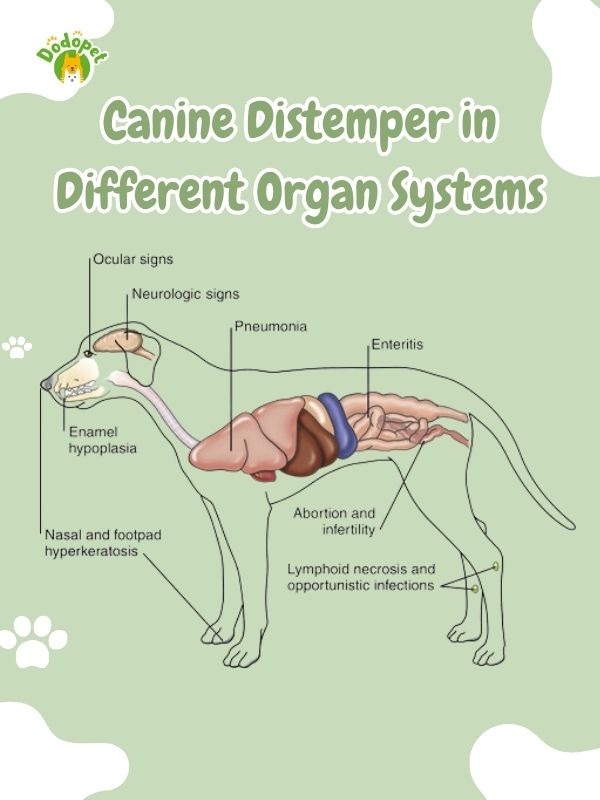
Canine Distemper in Different Organ Systems
Preventing the Spread of Dog Diseases Distemper
Preventing the spread of canine distemper is crucial to protect both individual dogs and the overall dog population.
Here are some important measures to take:
- Vaccination: To ensure the well-being of your canine companion, it is imperative to provide appropriate vaccinations based on their age and potential risk factors. It is advisable to consult with a veterinarian to determine the most suitable vaccination schedule for your dog.
- Isolation: In the event of a distemper diagnosis in a dog, the utmost priority is to isolate them to prevent any further transmission. This entails keeping the infected dog away from public areas and ensuring that they have no contact with other dogs.
- Hygiene: Maintaining good hygiene practices is essential in the prevention of distemper. Regularly washing hands, disinfecting surfaces, and diligently cleaning food and water bowls are paramount. Such practices significantly mitigate the risk of transmission through contaminated objects.
- Avoiding Wildlife: To minimize the likelihood of exposure to the distemper virus, it is advised to restrict interactions with wildlife. When taking your dog for walks, it is prudent to keep them on a leash and steer clear of areas where wildlife is known to be present. This precautionary approach is key to safeguarding your dog’s health.
- Reporting Outbreaks: If you suspect an outbreak of distemper in your area, report it to local authorities or animal health organizations. This can help in implementing appropriate control measures and preventing further spread.
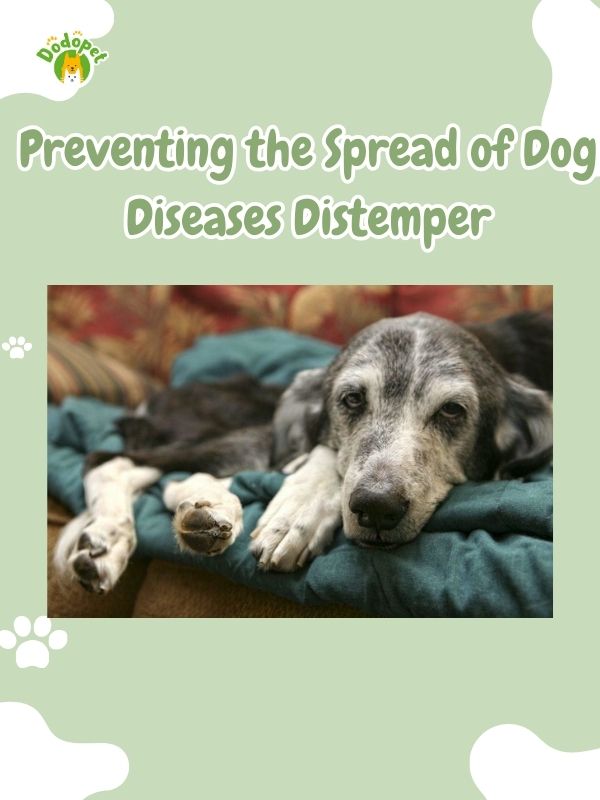
Preventing the Spread of Dog Diseases Distemper
Conclusion
Canine distemper, a severe viral disease, has the potential to wreak havoc on dogs’ health. It is crucial for both dog owners and veterinarians to grasp the symptoms, treatment choices, and preventative tactics involved.
Foremost, vaccination stands as the most potent approach to stave off distemper. Nevertheless, augmenting this strategy, it’s imperative to adhere to sound hygiene practices and curtail contact with infected animals. Through these combined efforts, we can actively contribute to diminishing the prevalence of canine distemper and safeguarding the well-being of our cherished canine companions.









